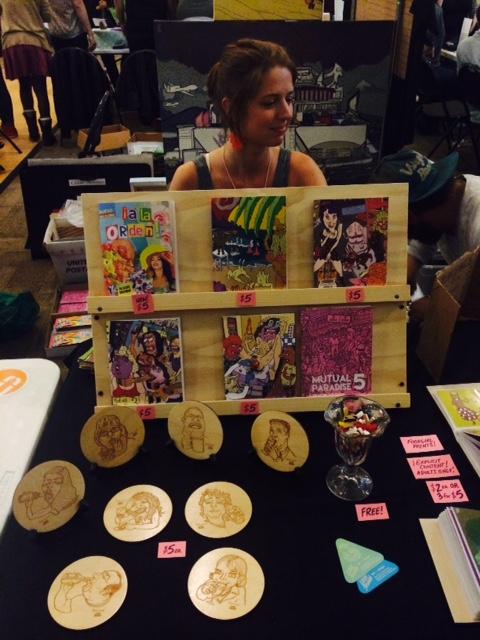

Lizzee Solomon displays her original art at the Zine Festival. Britnee Meiser | Staff Writer
A Mexican travel guide. A Kim Kardashian coloring book. Bernie Sanders memorabilia.
However varied these items are, they co-existed terrifically as zines displayed on neighboring tables at Pittsburgh’s fifth annual Zine Fair last Sunday, waiting for artists to purchase or trade them.
A zine, short for fanzine, is a self-published piece of work similar to a magazine. Zines can be about anything — literature, comics, photography, fanfiction — it doesn’t matter. The fair is put on every year by artists and volunteers dedicated to the craft of zine printing.
At the fair in the Union Project, a Highland Park church-turned-artistic venue on Negley Avenue, zine publishers paid either $10 or $20 — depending on table size — to set up a table and showcase, share or sell their work. This year, there were 42 vendors sharing a few dozen tables, as approximately 530 people cruised the aisles in the large assembly hall.
“I like coming to support my friends,” said Pitt research specialist Andres Gutierrez, who has attended the fair for the past couple years. “[The Zine Fair] is a mix of Pitt Students, former Pitt students, CMU students—the whole Pittsburgh scene.”
Vendors displayed their zines, and any other original creations for sale, in whatever fashion they liked. Add in a few hundred people at a time and a Pgh Taco stand outside, and the result was equal parts colorful and crazy.
All the money the Zine Fair makes — from sponsorships and tabling fees — goes toward creating next year’s fair. Its volunteers are Pittsburgh artists, writers and print makers, who created and promoted the fair.
Event coordinators — who are self-appointed volunteers — began meeting in June, and continued weekly meetings up until the fair where they secured the venue, reached out to promoters and sponsors, wrote press releases and designed posters, all in preparation of the event.
“[The Zine Fair] is a great opportunity to get your work out there, and is by far the best event to make a profit,” said Lizzee Solomon, a CMU graduate and zine creator. She has published five issues of her original, comic-based zine “Mutual Paradise.”
The zine creation process is different for everyone, but hard work remains constant. For Solomon, it begins with the pencil work—writing and drawing the comics. Then, she scans the images into the computer and uses Photoshop to create the page layout and size. Finally, she takes them to the printer, which is the only part of the process where she has any help.
“I wouldn’t do this if I didn’t love it,” said Solomon. “It’s not quick and it doesn’t make much money. But coming back [to the Zine Fair] and having people come up to you and tell you they liked your zine and want the newest [issue] — it’s really rewarding.”
Solomon has attended Pittsburgh’s Zine fair every year since it began in 2011. She sells her zines for $5 a piece.
While zines can be a fun side-business for creators, some see trading with other zine makers as even more beneficial.
“Trading becomes a conversation that lends itself to developing the community, which is what we’re all about. You’ve invested your heart in the work, and you want to distribute it,” said event organizer Juan Fernandez. Fernandez creates comic zines and runs the Pittsburgh Comic Salon — an organization that brings together local comic writerss and cartoonists.
In creating the Zine Fair, Fernandez and co-coordinator Raiona Gaydos aim to make a space that promotes direct communication between zine creators and readers.
“There’s something powerful about the physicality [of the zine],” said Gaydos. “It’s all direct. There’s no middleman, no institution of publishers telling you what you can and can’t do.”
Gaydos and Fernandez recognize the significance of zines acting as outlets for writers and readers who have trouble communicating verbally. For those people, Fernandez said, zines are the best form of self-expression.
“So long as you have the gumption to write something and print it, a conversation will happen,” he said. “That’s the immediacy [and] legitimacy about zines.”
As the Zine Fair’s influence spreads, the artist-reader conversations that Fernandez and Gaydos hope for will become inevitable. From fandom and pop culture junkies to science lovers and political enthusiasts, as the fair proves, there’s a zine for every interest.
“It brings a sense of community,” said Gutierrez, “and creates a common forum that says it’s okay to express yourself whatever way you want to.”
Recent Posts
SGB addresses concerns about ICE presence on campus, hears SJP lawsuit against administration, approves governing code bill
At its weekly meeting on Tuesday at Nordy’s Place, Student Government Board heard concerns about…
ACLU of Pennsylvania sues Pitt over SJP suspension
The ACLU of Pennsylvania filed a federal civil lawsuit against the University of Pittsburgh and…
Marquan Pope: The ultimate shark
One of the most remarkable things about sharks is that an injury doesn’t deter them.…
Who Asked? // Do we really get a summer vacation?
This installment of Who Asked? by staff writer Brynn Murawski mourns the seemingly impossible perfect…
Notes From an Average Girl // Notes from my junior year
In this edition of Notes From an Average Girl, senior staff writer Madeline Milchman reflects…
Meaning at the Movies // The Power of the Movie Theater
In this edition of “Meaning at the Movies,” staff writer Lauren Deaton discusses her love…